Shoyu Tare is the soy sauce seasoning and concentrated flavor base used in Japanese Shoyu Ramen. Tare is one of the most important elements in a good bowl of ramen. This is Part 1 of the Ramen At Home series for Traditional Shoyu Ramen.
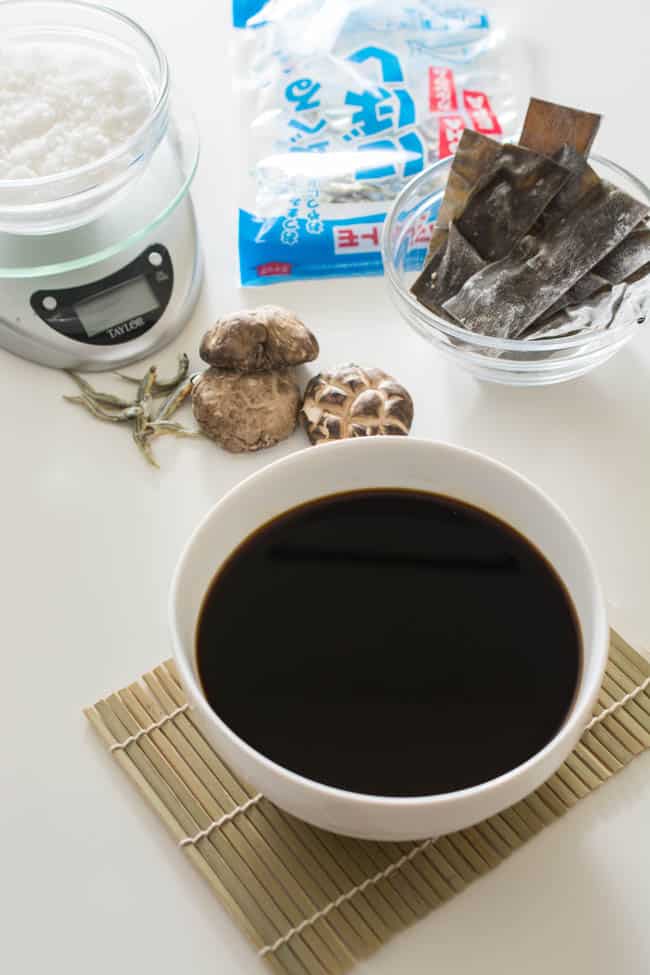
Tare is one of the most important ingredients in a good bowl of ramen. It is the concentrated base that enhances the soup by adding salt and flavor. When you go to most ramen shops, you'll often find the ramen categorized by tare.
The most common are miso, shio (salt), and shoyu (soy sauce).
This Shoyu Tare recipe is from the "Ramen at Home" cookbook by Brian MacDuckston of ramenadventures.com, and Part One of a six-part series featuring his Traditional Shoyu Ramen recipe.
Here are the links to the rest of the posts in this series:
- Chicken Chashu
- Menma (Seasoned Bamboo Shoots)
- Half-Boiled Ajitama (Seasoned Eggs)
- Basic Clear Chicken Soup
- TRADITIONAL SHOYU RAMEN
How to Make Shoyu Tare
Grind 1 oz of dried fish and 1 large dried shiitake mushroom into a powder using a food processor. I used a Magic Bullet blender and it did the job perfectly. For the dried fish, Brian recommends anchovy, bonito or sardine).
I used anchovy in this recipe and really loved the flavor.
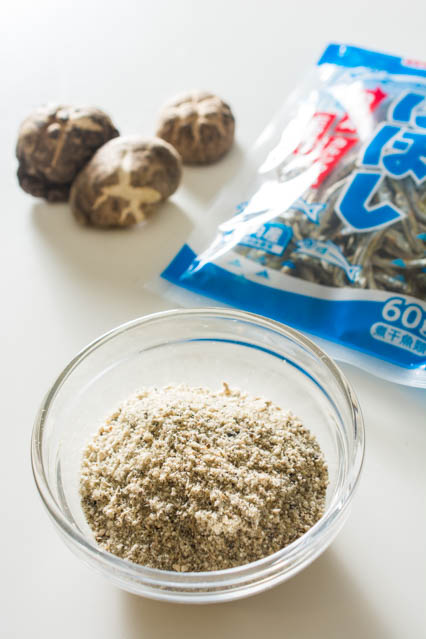
Next, put 2 ½ cups of water (see note below) in a large stockbot and add 2 oz of konbu.
Simmer for 2 minutes, then remove and discard the konbu.
Note: The recipe in the cookbook calls for 1 ¾ cups of water, but the konbu and mushroom powder tends to absorb quite a bit of water so I would recommend adding more water so that there is more yield after you strain it.
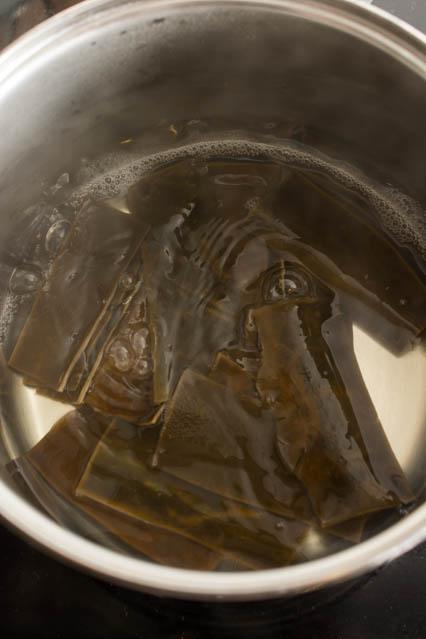
Add the fish-and-mushroom powder to the simmering water and bring it to a boil again. When it boils, remove it from the heat, and strain the liquid through a paper or cloth filter.
Brian recommends using a coffee filter for this task - brilliant! I used this and it worked perfectly.
Place the coffee filter in a large colander, then strain the tare liquid through it.
As mentioned earlier, the fish-and-mushroom powder does absorb a good amount of the water, so after the liquid has drained on its own (and cooled down!), squeeze the excess liquid from the pulp. I spooned the pulp on to a fresh coffee filter then used my hands to squeeze the excess liquid.
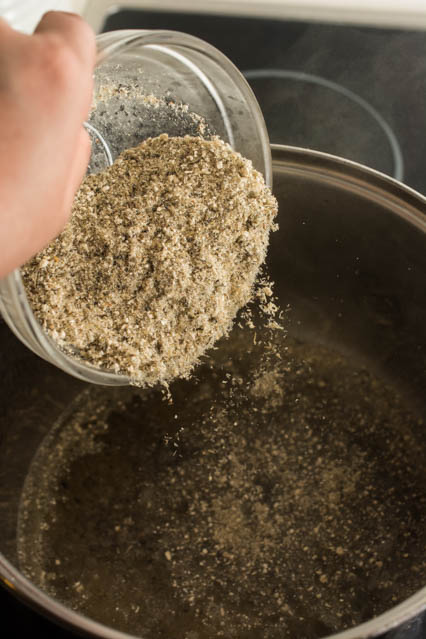
Would you like to save this?
Use a weighing scale to weigh the liquid. I ended up with 6.5oz.
Calculate 17% of this weight. This is the amount of salt you will add.
Using mine as an example, 17% of 6.5oz would be 1.105oz. (6.5 X 0.17 = 1.105)
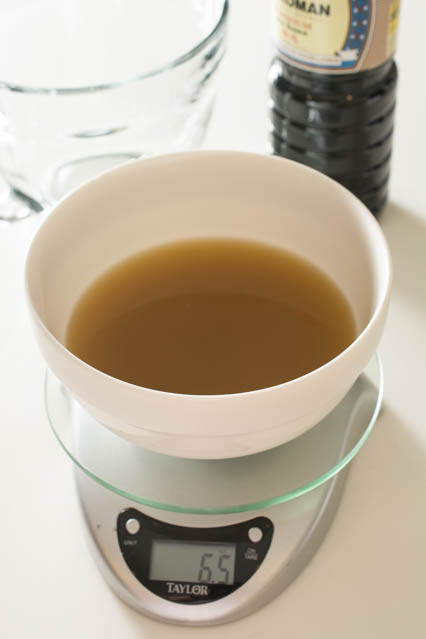
Measure that amount in salt.
Add the salt to the liquid and mix well.
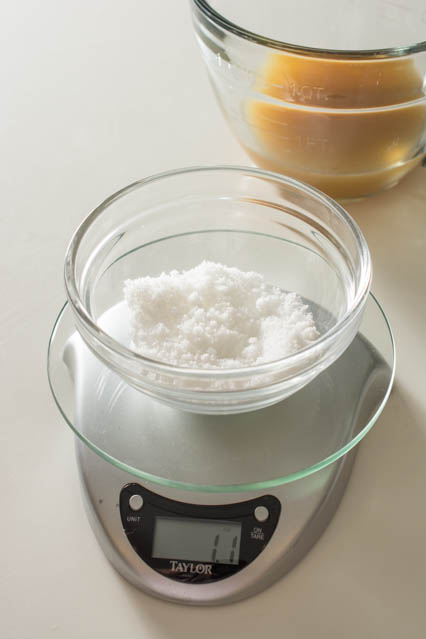
Alternatively, if you do not want to use a weighing scale, you can measure out exactly 2 cups of the liquid (so you'd have to start with more water at the start) and add ⅓ cups + 1 teaspoon of salt.
Pour the liquid-and-salt mixture into a measuring cup. Measure out the same amount of *dark soy sauce (koikuchi) and add it to the bowl. Mix well.
I got almost 1 cup of the liquid-and-salt mixture, so I added 1 cup of soy sauce.
*A note about dark soy sauce: Japanese dark soy sauce is NOT the same as Chinese dark soy sauce so be sure to purchase a Japanese dark soy sauce for this recipe.
Chinese dark soy sauce is usually very thick and slightly sweet.
Japanese dark soy sauce, on the other hand, is very commonly used every day. Kikkoman brand soy sauce is often found in most restaurants across the United States and is considered a "dark soy sauce" in Japanese cuisine.
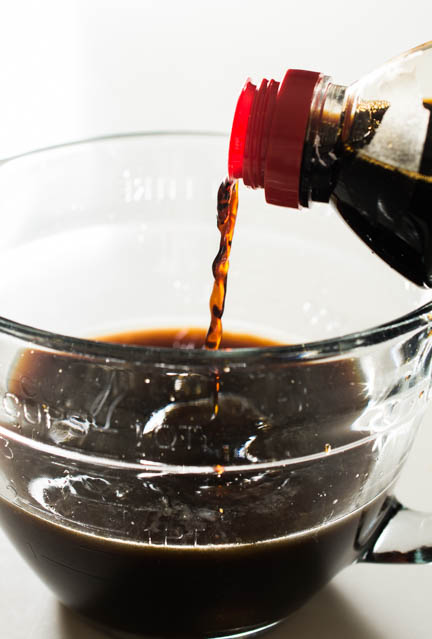
The tare will keep in an airtight container in the refrigerator for a few months.
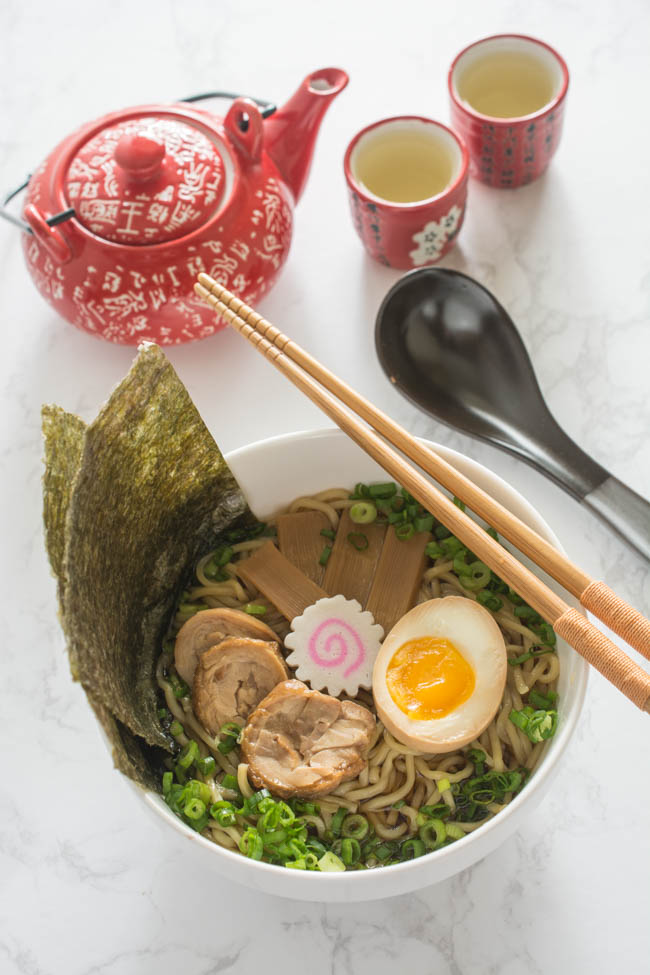
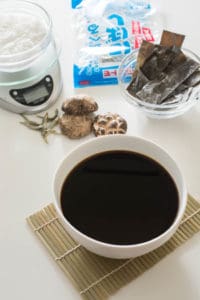
Shoyu Tare (Soy Sauce Seasoning for Ramen)
Ingredients
- 1 oz dried fish anchovy, bonito, or sardine
- 1 piece dried shiitake mushroom about 1 oz
- 2 ½ cups water
- 2 oz dried konbu
- salt (17% by weight, or ⅓ cup + 1 teaspoon)
- 2 cups dark soy sauce (Japanese) koikuchi
Instructions
- Use a spice grinder to grind the dried fish and dried shiitake mushroom into a powder.
- Put the water in a large stockpot and add the konbu. Bring it to a boil. Simmer for 2 minutes, then remove and discard the konbu.
- Add the fish-and-mushroom powder to the simmering water and bring it to a boil again. When it boils, remove from the heat and strain the liquid through a paper or cloth filter (a coffee filter works well for this).
- If measuring the salt by weight, measure the weight of the liquid using a kitchen scale. Add 17% of this weight in salt.
- Alternatively, measure out exactly 2 cups of the liquid and add 1⁄3 cup plus 1 teaspoon of salt. You will discard some of the liquid you made and thus have less tare in the end. (Again, it’s best to use the weight measurement.)
- Mix the salt in well.
- Pour the liquid-and-salt mixture into a measuring cup, then transfer to a large bowl. Measure out the same amount of soy sauce and add it to the bowl. Mix well.
- The tare will keep in an airtight container in the refrigerator for a few months.
Nutrition
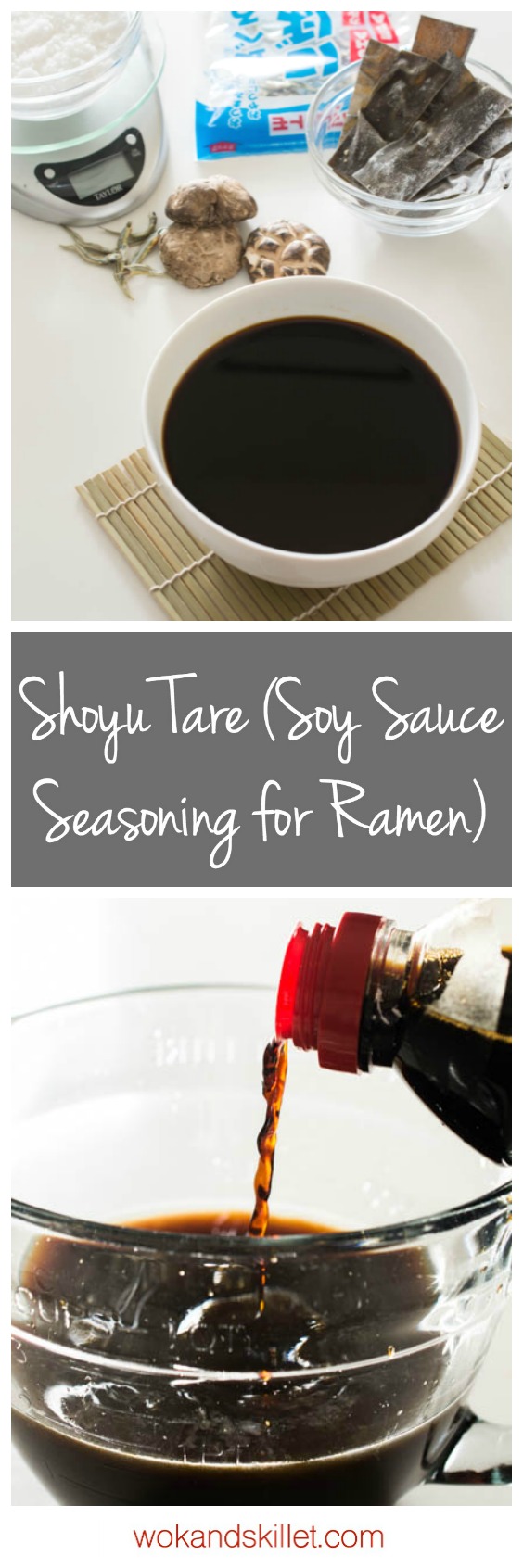


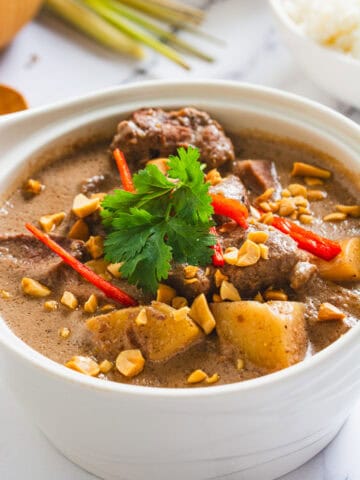
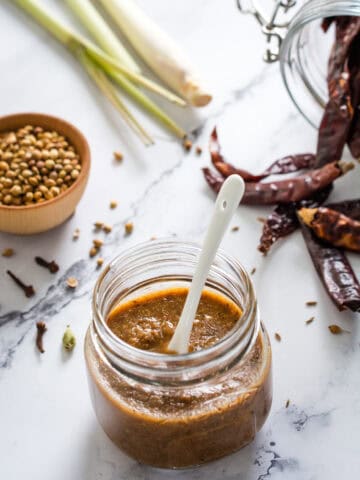
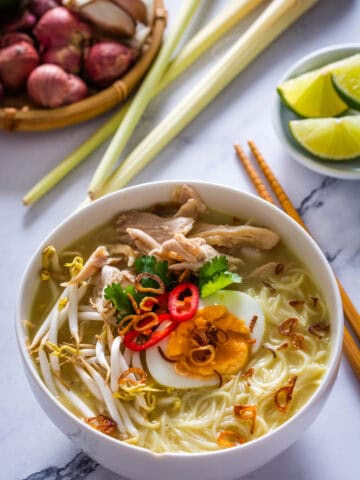
Steven VanAernem says
Hi Char.
Thanks for posting this. I have a couple questions for you. Can I use Bonito stock powder in place of the anchovies? How much of the finished Tar'e do you use per bowl of noodles? Just a spoonful or the entire batch for one bowl? Lastly, if it is just a big spoonful, can I freeze it in ice cube trays to use as needed?
Sorry for so many questions, I just want to make sure I'm getting this right and doing justice to your instruction. I wish you well and thank you in advance for any response.
Char says
Hi Steven. Thanks for reaching out!
I would recommend using dried bonito instead of the bonito stock powder if possible. The stock powder will give you a bit of a different flavor as it has added ingredients including additional salt, which could make your tare a bit too salty.
You will need 1/2 cup of tare for 4 servings of ramen, so 1 bowl is about 2 tablespoons. You can certainly freeze them in ice cube trays - that is brilliant!
I hope this helps. Have a great day!
~Char
Steven VanAernem says
UPDATE: I made this yesterday and it is stunning! For anyone out there trying to decide if you should make this or if you really need it, the answer is yes on both counts. This recipe is nothing short of a flavor bomb. As soon as I tasted it, my mouth began to water and taste buds I wasn't even aware of came to life. It really is that good.
I also froze mine into ice cube trays and can see myself adding some to so many dishes for an extra boost of umami goodness. Making Kimchi-jjigae tonight and will definitely be adding a cube.
Thanks again Char, this really is a game changer for me.
Char says
Hi Steven! Thanks so much for trying this recipe (by Brian MacDuckston) and for taking the time to leave this comment. I'm so thrilled that you enjoyed it! It is definitely super flavorful. Have a great day!
vimal says
HI DO YOU HAVE A VEGAN VERSION ??
Char says
Hi Vimal! I'm sorry; I do not have a Vegan version of this recipe at this time. Perhaps you could try this one by K33 Kitchen?
https://www.k33kitchen.com/recipes/japanese-shoyu-ramen/
Hope that helps! Cheers!
shauna says
Just wanted to lelt you know that our facebook group "Japanese food and recipes" which has 78.6k members has featured your blog post on shoyu tare for our ramen month as we love your post and blog. I hope you'll join us! Feel free to join and pm me. I"m the main admin Shauna F. in the group. https://www.facebook.com/groups/245105925863935
Thanks again and have a wonderful day!
Char says
@shauna, Hi! That is amazing!!! Thank you so much!!
Dave says
I love this recipe. I’m up to my fourth batch of it, I keep a stoppered glass bottle of it behind my fridge door at all times. I usually use an anchovy/bonito flake mixture, whatever I have on hand, it always works!
I’ll add one suggestion- don’t throw out the konbu and fish/mushroom powder afterwards! I chuck my konbu on a blender (with some nori or wakame if I have them on hand) then throw it, the fish/mushroom powder, a good handful of toasted sesame seeds, a slosh of sesame oil, some shoyu and salt into a hot frypan and fry it, stirring constantly until everything is mixed well and all the liquid is evaporated. Then I cool and save the mixture to use as furikake (rice seasoning).
Char says
Dave, thank you so much for taking the time to leave this comment! I'm so glad you're enjoying this recipe. What a great idea to save the powder to re-use it as a furikake. Brilliant!!
Jbraun says
I am sorry if I missed this, but... What is the Tare to broth ratio for the Shoyu? I bought Brian's book and I can't find it on page 62.
Char says
@Jbraun, Hi there! For Shoyu Ramen (https://www.wokandskillet.com/traditional-shoyu-ramen/), it's 1/2 cup of tare for 5 cups of chicken broth. This will give you 4 servings. Hope this helps!
Jbraun says
@Char, thank you,
But... There are not 5 cups in one bowl of Roman right?
Jbraun says
@Char, ignore last comment. Thank you!!!
Sara says
Hello,
This recipe look awesome, but I have a concern. How much is 1 cup in terms of cl or ml?
Char says
Hi Sara! 1 cup (US measurement) is 236ml.
Sara says
Hello!
One additional question: How much soy sauce to use?
In the list of ingredients it says that there are two cups (in grams?), but in the instructions you say that you only used one cup because it was the equivalent of liquid + salt.
Char says
Hi Sara. Sorry for the confusion! I recommend getting 2 cups of soy sauce ready, but you may not use all of that amount. After you add the salt to the liquid, pour it into a measuring cup and make note of that amount, then measure that same amount of soy sauce to add. I hope this helps!